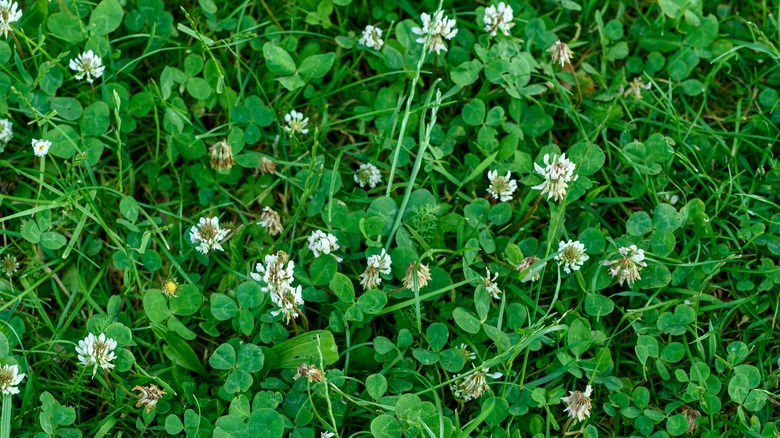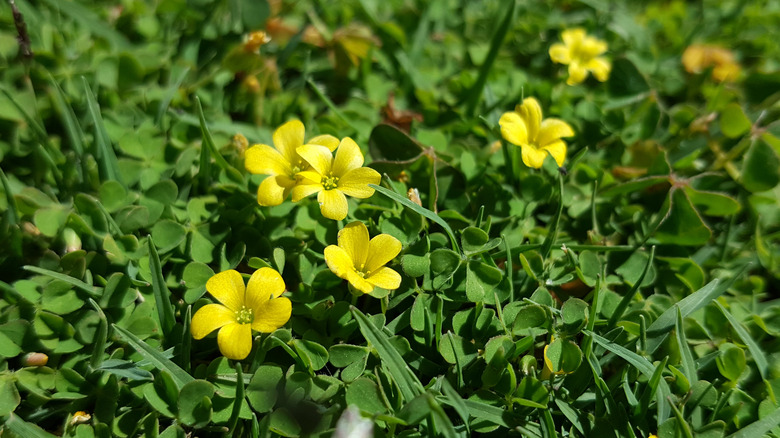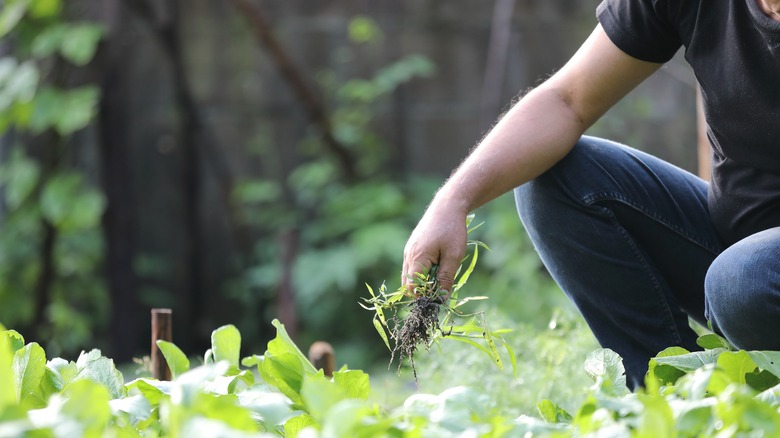Don't Mistake This Heart-Shaped Weed For Common Clover. Remove It Immediately
Clover can be fantastic in lawns thanks to its abilities to improve soil and assist turfgrass growth, but if you look closely, you may notice that some of the clover-like plants in your lawn are actually imposters. Instead of growing a clover lawn, you may actually have yellow woodsorrel (Oxalis stricta), an aggressive species that can quickly take over your yard. Luckily, differences in flowers and leaf shape make it possible to distinguish woodsorrel from clover and remove the unwanted weed before it can spread.
Despite being native to North America, woodsorrel is generally an unwanted presence in yards and gardens. Not only is it shockingly fast growing for a perennial and able to aggressively spread through asexual reproduction, but it can also produce large numbers of seeds which it is able to launch up to 12 feet. Yellow woodsorrel is able to thrive under a variety of soil conditions and can handle everything from full sun to part shade, making it a constant nuisance for gardeners in USDA zones 3 through 7.
Look at leaves and flowers to distinguish yellow woodsorrel from clover
The easiest time to identify yellow woodsorrel and distinguish it from clover is when it is flowering. Unlike clover, which has globular,or ball-shaped, flowers colored white and pink, yellow woodsorrel boasts small open yellow flowers with 5 petals. Woodsorrel's flowers eventually turn into cylinder shaped seedpods. Unfortunately, if you wait until your woodsorrel is flowering or creating seed pods before identifying it, you may be too late to prevent it from spreading.
Identifying and removing woodsorrel when it is still young is the best way to prevent it from spreading and turning a small inconvenience into a large problem. To identify young wood sorrel you need to look carefully at the leaves. While both clover and yellow woodsorrel have trifolate, or three part, leaflets, clover's leaflets are rounded, giving them a teardrop shape, while woodsorrel's leaflets have two lobes, giving them a more heart-shaped appearance.
Pull woodsorrel from the ground by hand
You have several options to control yellow woodsorrel in your lawn, as both mechanical and chemical methods can be effective. If possible, start your woodsorrel eradication efforts early in the season before the plants can flower. This is also the best time to get rid of most of your lawn's other weeds. Small patches of woodsorrel can be pulled or dug up by hand; just be sure to get as much of the rhizomes as possible to prevent it from growing back. As long as you haven't used herbicide, you don't have to throw out the plants either, as wood sorrel is edible and has a lemony flavor that makes it popular in salads and teas. It should only be eaten in moderation though, as it does contain oxalic acid which can cause kidney problems in some people and in pets.
If your woodsorrel has spread too extensively to be managed by hand, then herbicides are also an option. Kansas State University has found that herbicides with the chemicals triclopyr and fluroxypyr are considered especially good options for managing weeds in the oxalis genus. As with most unwanted plants, though, the best defense against woodsorrel is a healthy thick lawn and a garden with plenty of ground cover plants or mulch to prevent weeds.


